Caution: Unless directed otherwise, the ignition and start switch must be in the OFF or LOCK position, and all electrical loads must be OFF before servicing
any electrical component. Disconnect the negative battery cable to prevent an electrical spark should a tool or equipment come in contact with an exposed electrical terminal. Failure to follow these precautions may result in personal injury and/or damage to
the vehicle or its components.
- Disconnect
the negative battery cable.
- Release the fuel pressure. Refer to
Fuel Pressure Relief
in Engine Controls.
- Remove the fuel filler cap in order to release the fuel vapor
pressure in the fuel tank.
- Replace the cap after the pressure has been released.
- Drain the cooling system. Refer to
Cooling System Draining and Filling
in Engine Cooling.
- Remove the air intake pipe from the ACL intake hose and the throttle
hose. Refer to Air Intake Pipe Replacement.
- Remove three bolts and the throttle cover from the intake manifold.
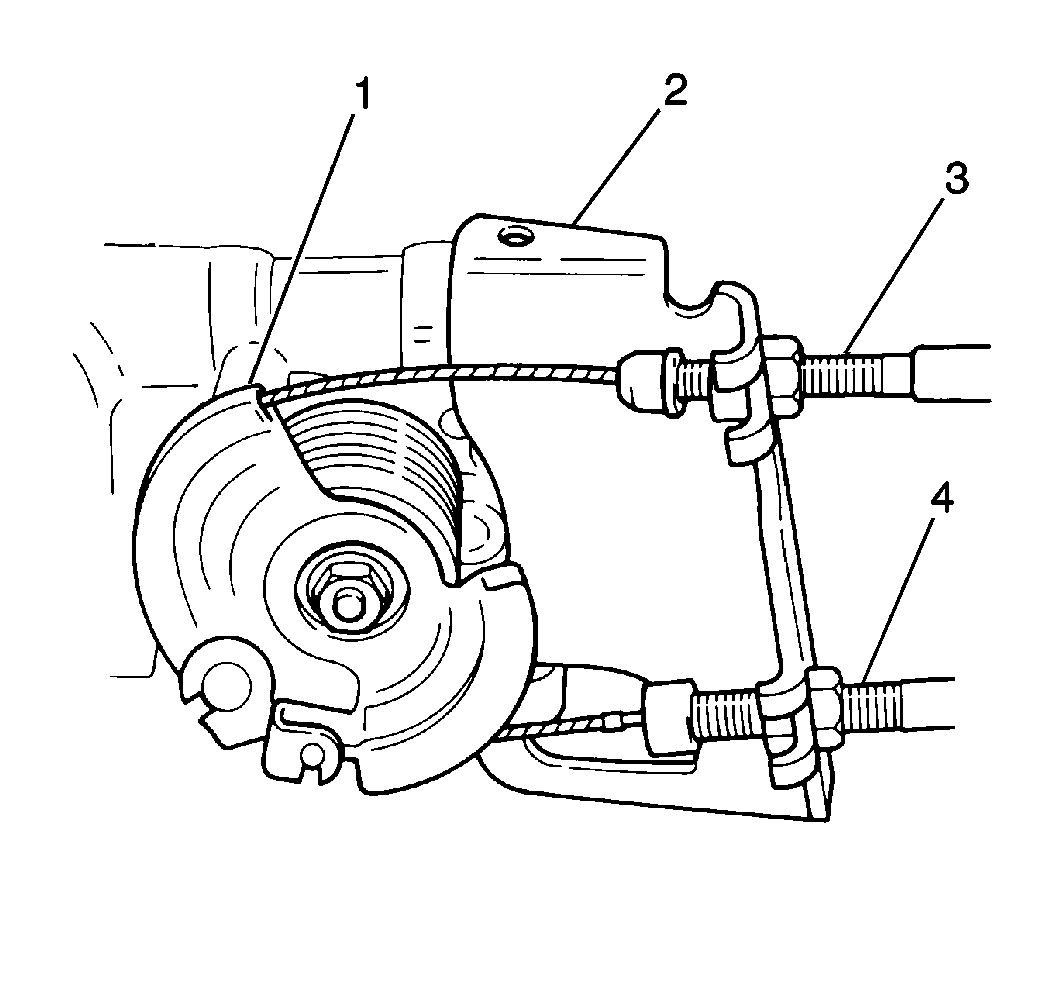
- Disconnect the accelerator
cable (3) and kickdown cable (4) (automatic transmission equipped vehicles)
from the throttle body bellcrank (1).
- Remove the following from the throttle body:
| • | The accelerator cable bracket (2) |
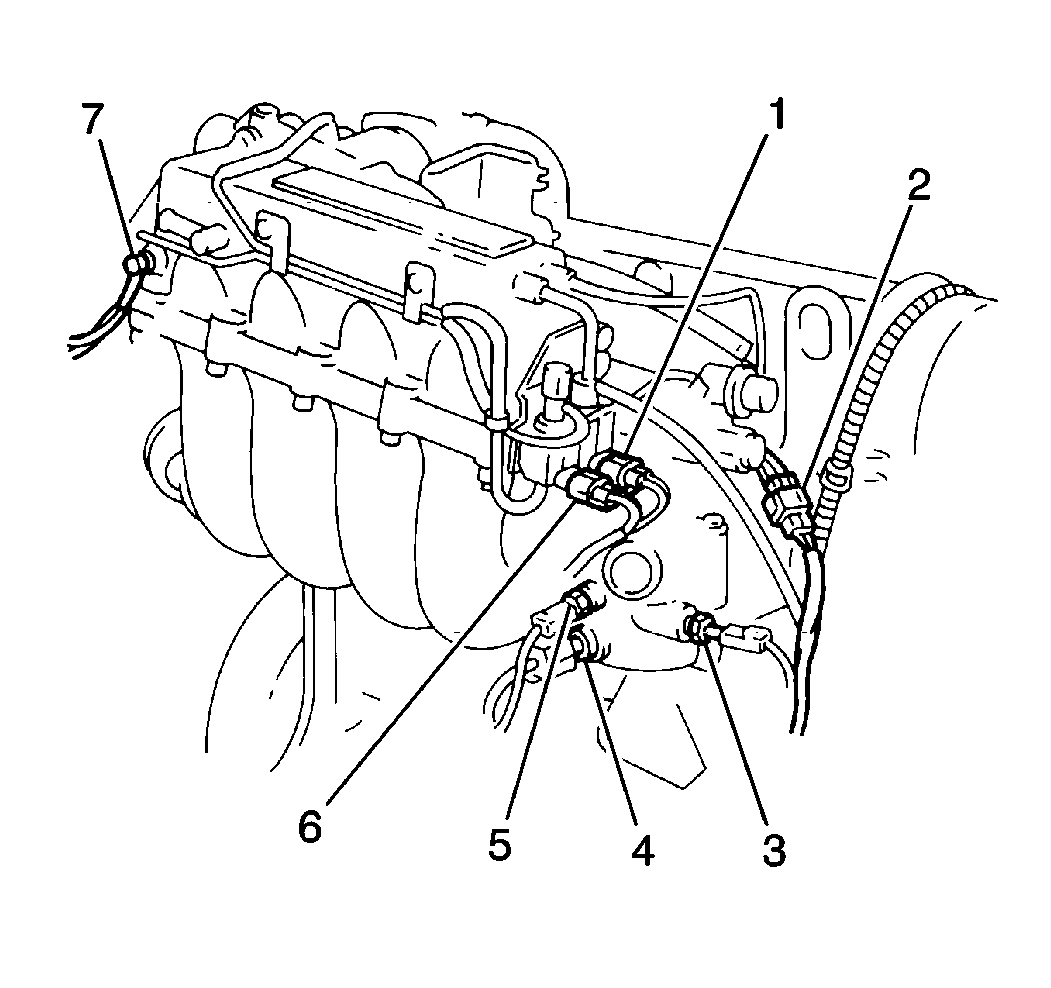
- Remove the following electrical
connectors:
| • | A/C ECT Switch (3) (A/C equipped vehicles only) |
| • | (EVAP) Canister Purge Valve |
| • | (EGR) Temperature Sensor |
| • | EGR Solenoid Vacuum Valve |
| • | Engine Ground Wire From Intake Surge Tank (7) |
- Remove the following vacuum hoses:
| • | EVAP Canister Purge Valve |
| • | Vacuum Modulator Supply Hose (automatic transmission equipped
vehicles) |
| • | Brake Booster Supply Hose |
- Remove the coolant hose from the IAC valve.
- Remove the IAC hose from the IAC valve.
- Remove the coolant hose from the fast idle air valve below the
throttle body.
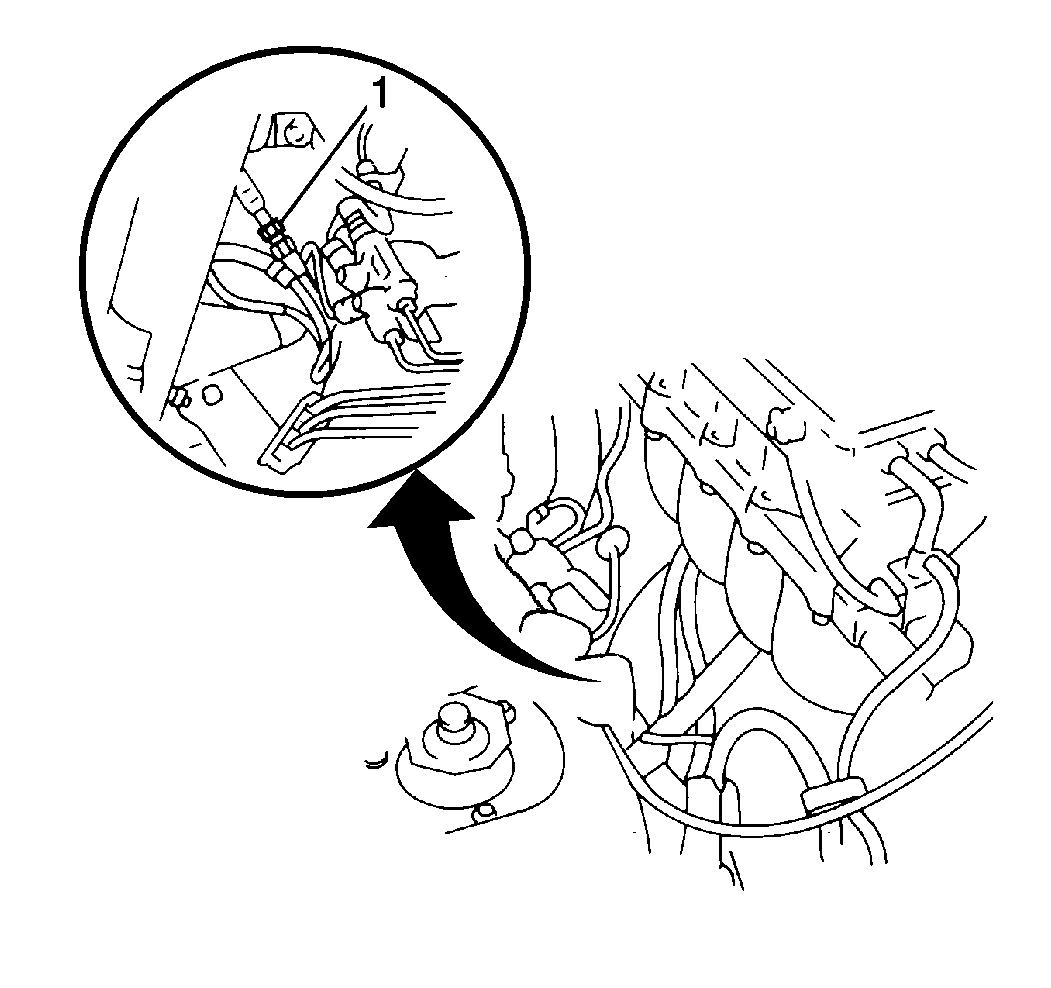
- Remove the fuel feed hose
at the fuel feed hose union (1).
- Remove the fuel return hose from the fuel return line.
- Remove the PCV hose from the PCV valve.
- Loosen the upper radiator hose clamp at the thermostat housing.
- Remove the upper radiator hose from the thermostat housing.
- Remove the coolant bypass hose from the intake manifold.
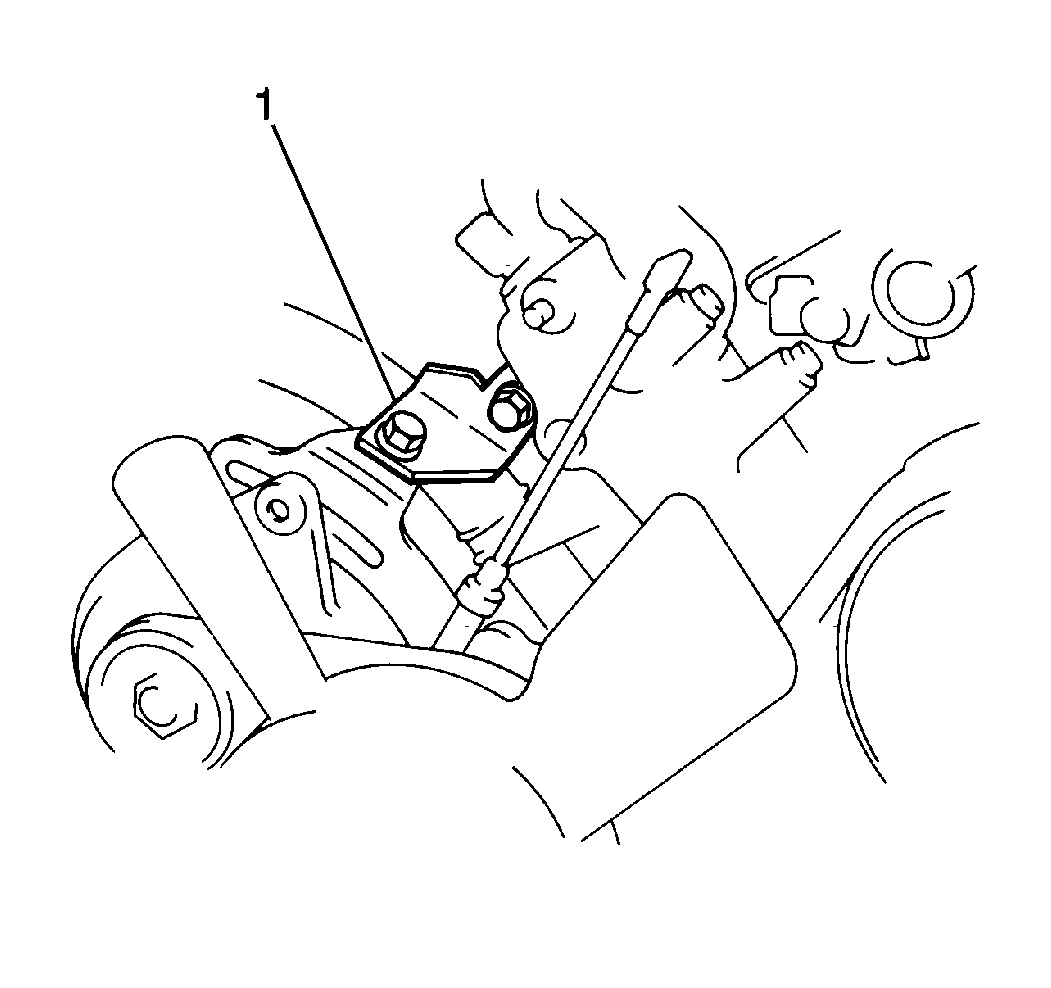
- Remove the following from
the intake manifold:
| • | The generator adjusting arm bracket (1) |

- Remove two bolts and the
front intake manifold reinforcement bracket (2) from the intake manifold.
- Remove two bolts and the rear intake manifold reinforcement bracket
(1) from the intake manifold.
- Remove two bolts and the lower intake manifold support bracket
(3) from the intake manifold.
- Remove the following from the cylinder head:
| • | The intake manifold with the gasket |

- Remove the following from
the exhaust manifold (2):
| • | The upper exhaust manifold heat shield (3) |
- Raise and support the vehicle. Refer to
Lifting and Jacking the Vehicle
in General Information.

- Remove the following from
the exhaust manifold and the engine block:
| • | The exhaust manifold reinforcement bracket (1) |

- Remove two bolts and the
lower exhaust manifold heat shield (6) from the exhaust manifold (2).

- Remove three bolts and
the front pipe/Three-Way Catalytic Converter (TWC) assembly (3) with the
gasket (2) from the exhaust manifold (1).
- Lower the vehicle.
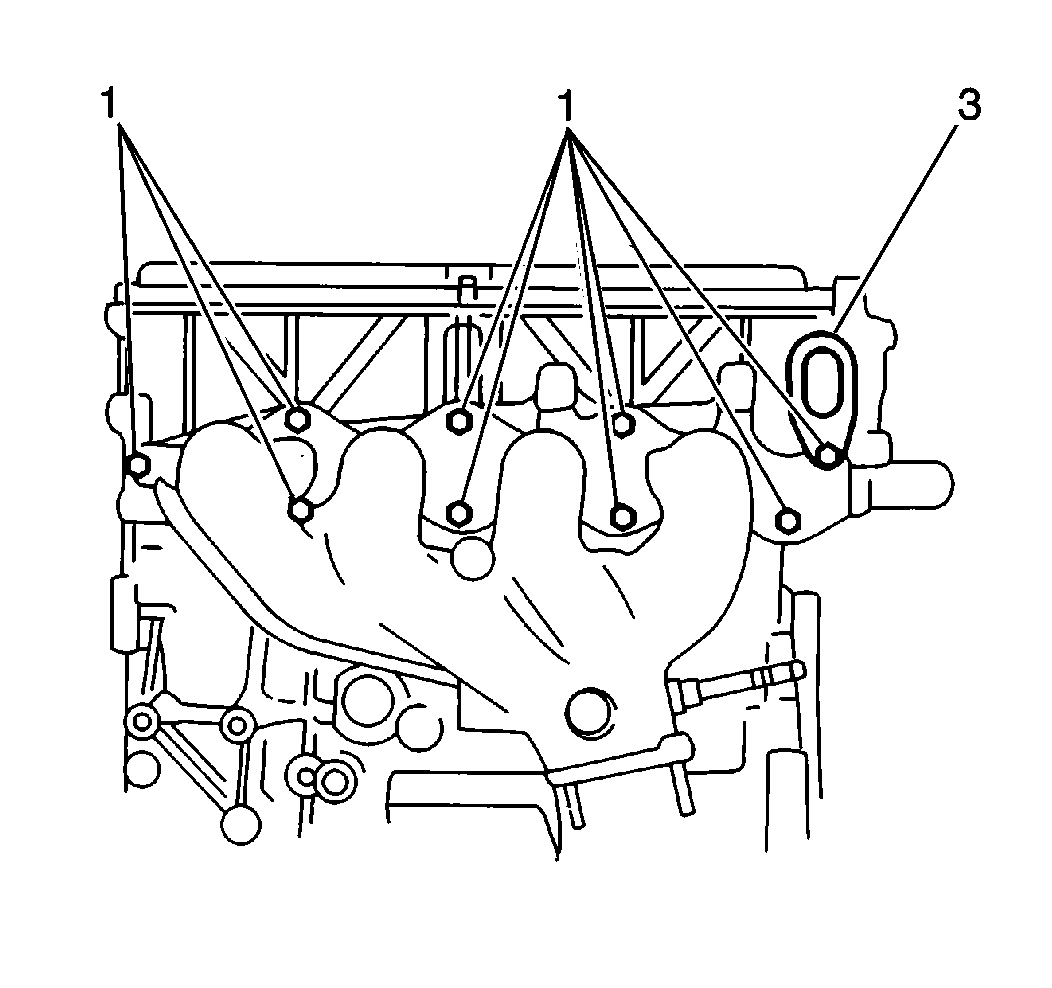
- Remove the nine exhaust
manifold nuts (1).
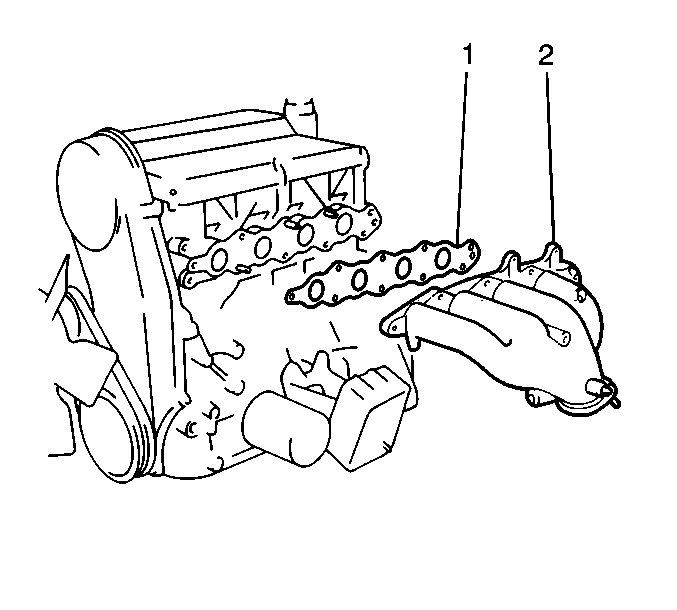
- Remove the exhaust manifold
(2) with the gasket (1) from the cylinder head.

- Remove the engine hanger
(3) from the cylinder head.
- Loosen the upper and lower A/C compressor mounting bolts (if equipped).
- Loosen the upper and lower power steering pump mount bolts.
- Remove the A/C compressor (if equipped) and/or power steering
drive belt from the pulleys.
- Loosen the upper and lower generator mounting bolts.
- Remove the generator/coolant pump drive belt from the pulleys.
- Remove four nuts, the cooling fan and the coolant pump pulley
from the coolant pump.
| • | The coolant pump pulley |
- Raise and support the vehicle. Refer to
Lifting and Jacking the Vehicle
in General Information.
- Remove four bolts and the front skid plate from the vehicle (if
equipped).
- Remove the two radiator shroud bolts.
- Lower the vehicle.
- Remove two bolts from the A/C suction line brackets at the right
side of the radiator core support (if equipped).
- Reposition the suction line for the radiator shroud removal access.
Important: If the radiator shroud is difficult to remove, drain the cooling system
and disconnect the upper radiator hose from the radiator to gain access.
- Remove the two upper radiator shroud bolts and the radiator shroud from
the radiator.
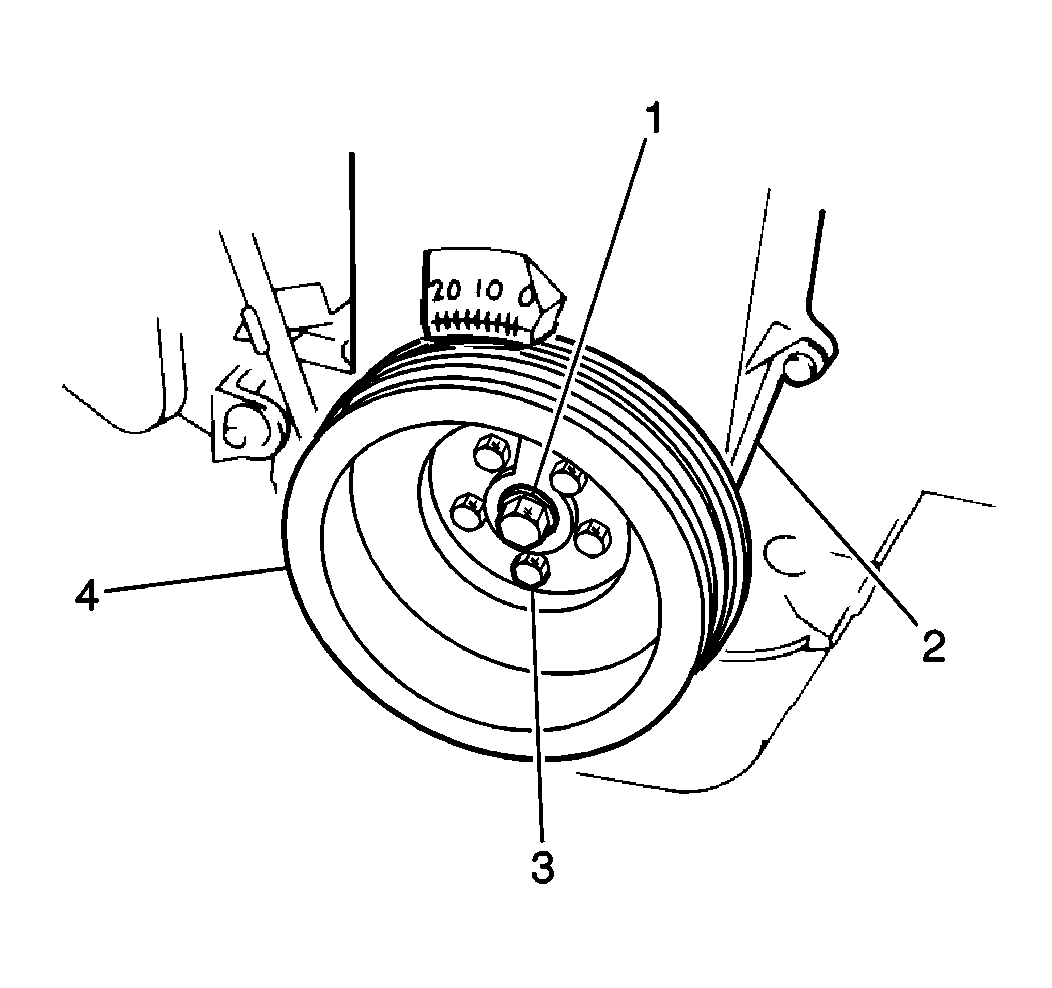
Important: It is not necessary to remove the crankshaft pulley center bolt when
removing the crankshaft pulley.
- Remove five bolts (3) and the crankshaft pulley (4) from the crankshaft.
- Disconnect the oil pressure sending unit wire conduit from the
timing belt cover.
- Remove the following from the engine:
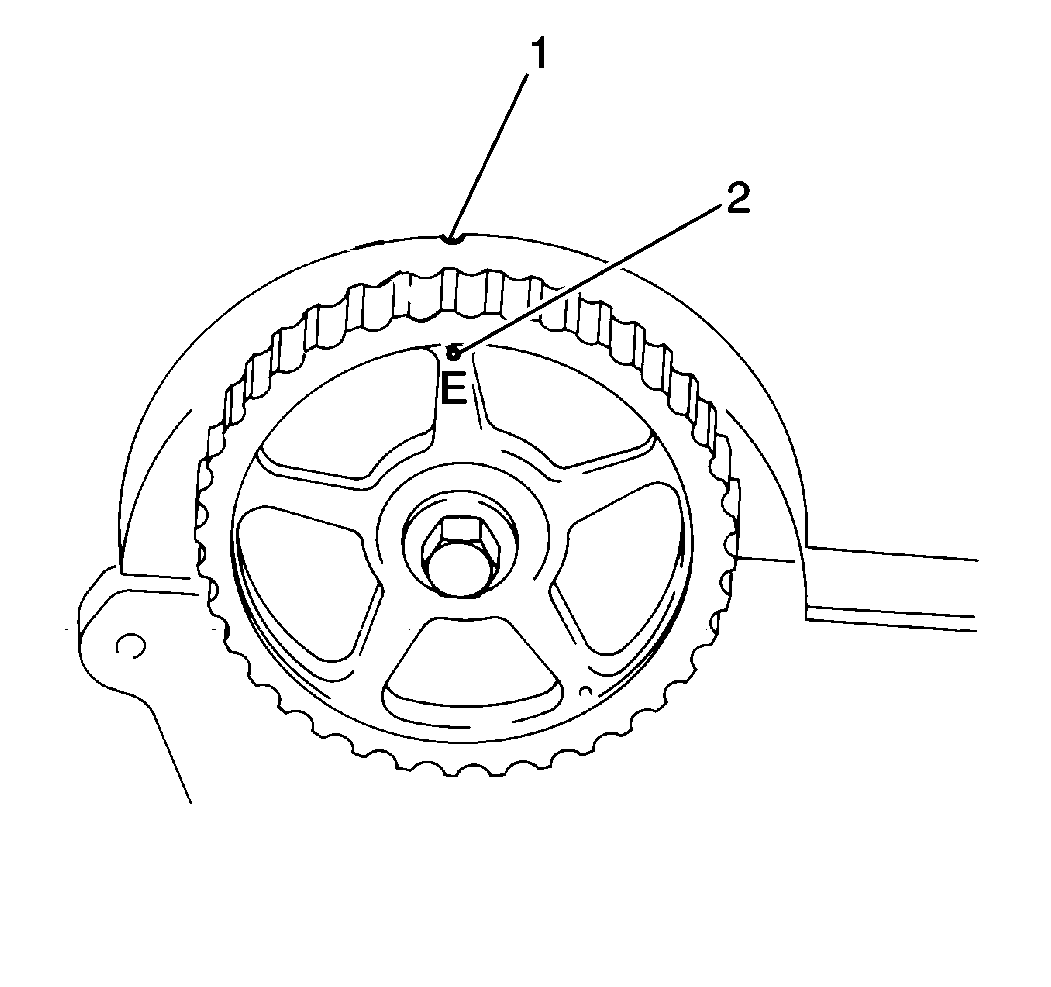
Important: There are two sets of timing marks which must be aligned to ensure the
correct engine timing upon the timing belt installation. A notch in the camshaft
timing belt gear designated as E (2) must be aligned with the notch in
the cylinder head cover (1). A punch mark on the crankshaft timing belt
gear should then align with the arrow in the oil pump casting. Ensure
alignment of both sets of marks prior to the timing belt removal to ensure
a correct timing belt installation as well as engine timing.
- Align the timing marks on the cylinder head cover (1) and the camshaft
timing belt gear (2).
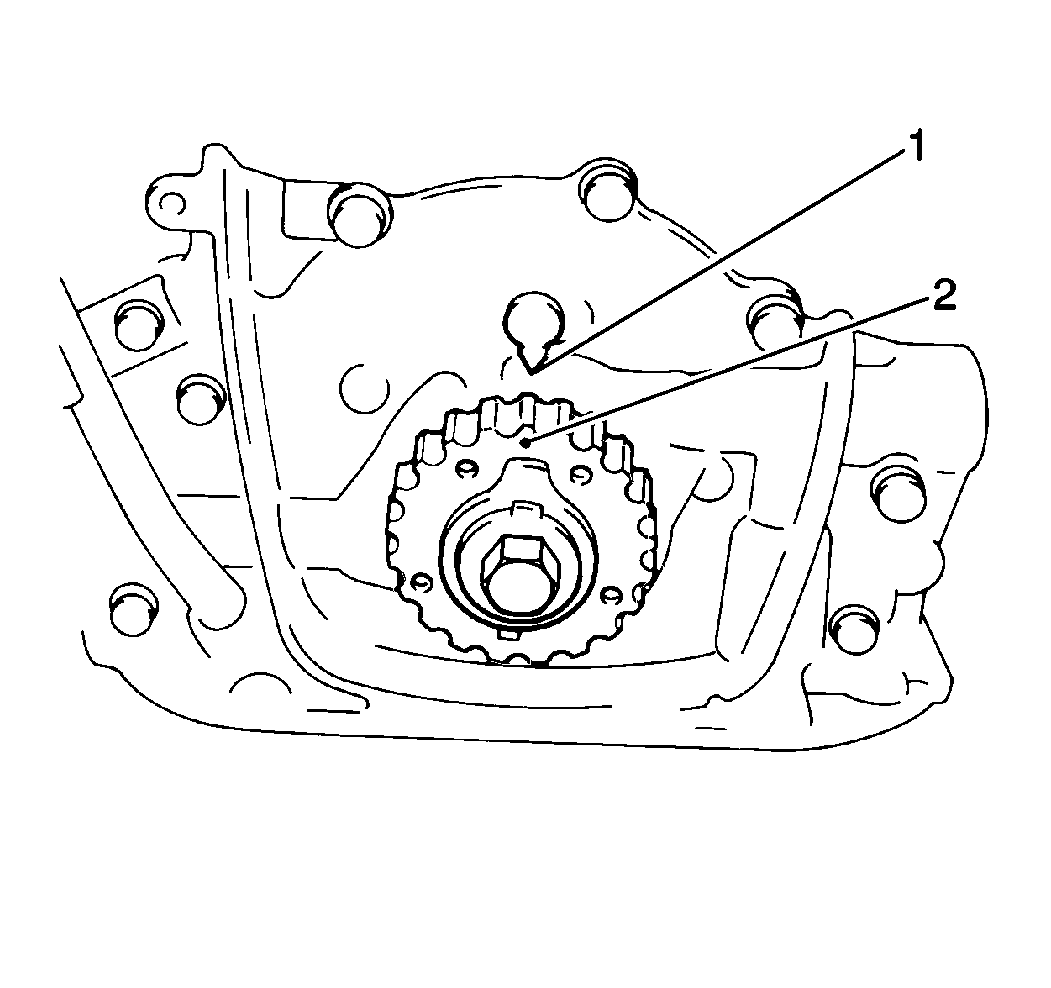
- Align the timing marks
on the oil pump casting (1) and the crankshaft timing belt gear (2).
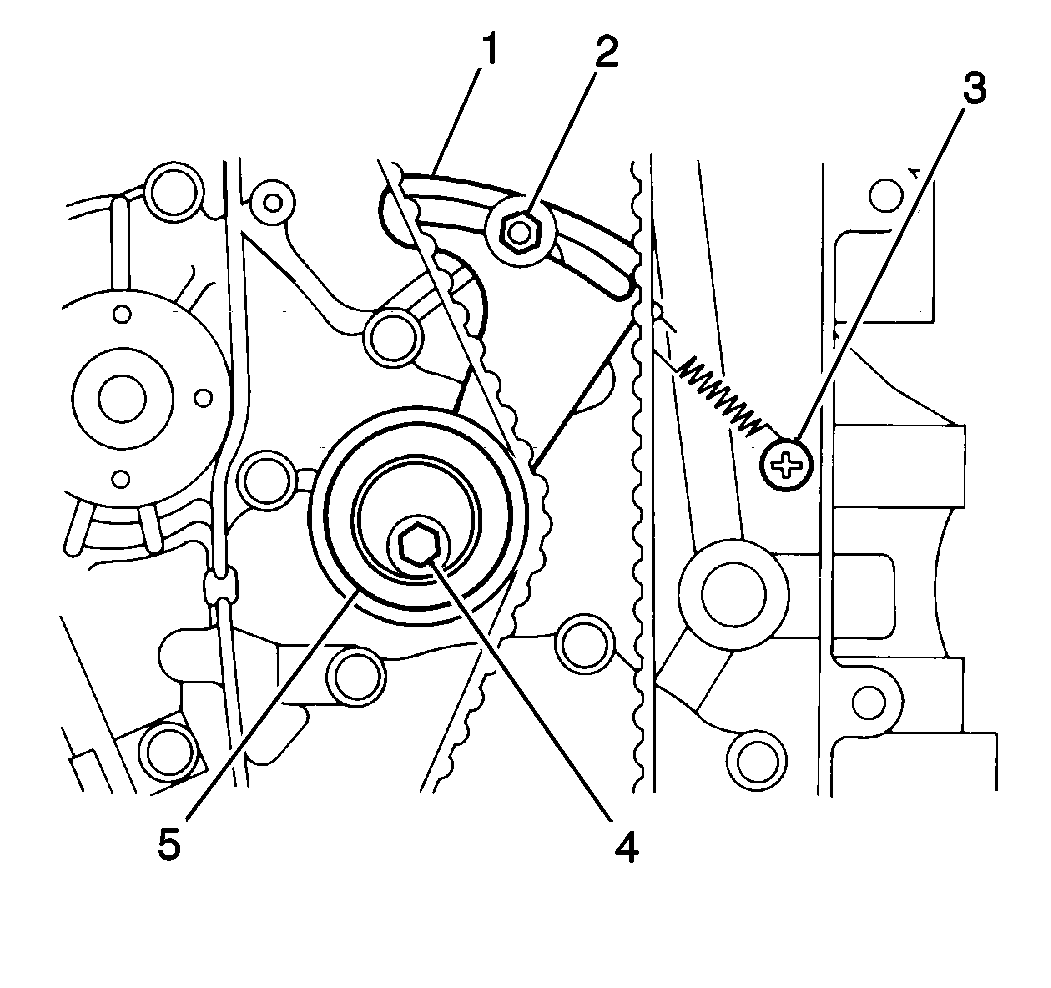
- Loosen the timing belt
tensioner bolt (4).
- Remove the timing belt tensioner spring from the timing belt tensioner
plate (1).
- Remove the timing belt from the camshaft and the crankshaft timing
belt gears.
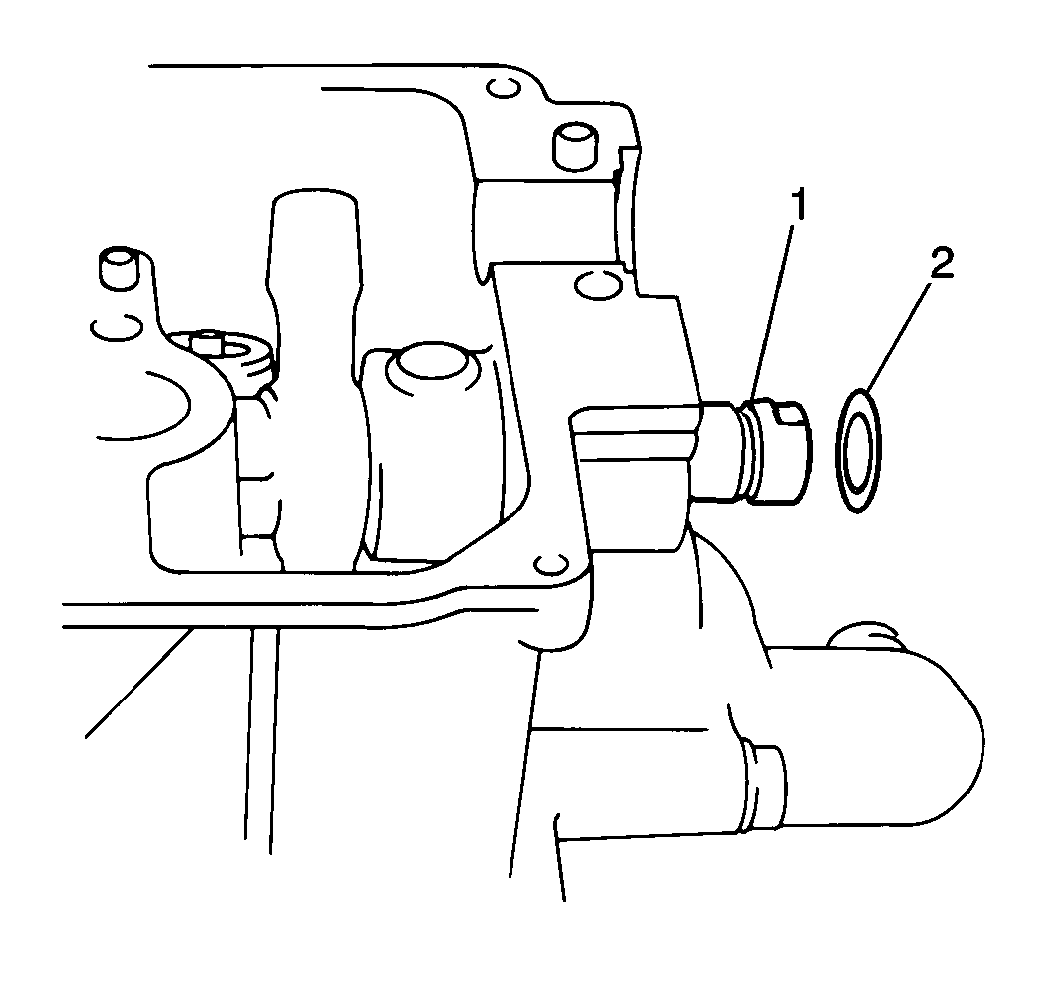
- Using a J 41040
in order to hold the camshaft timing
belt gear stationary, remove one bolt and the camshaft timing belt gear from
the camshaft.
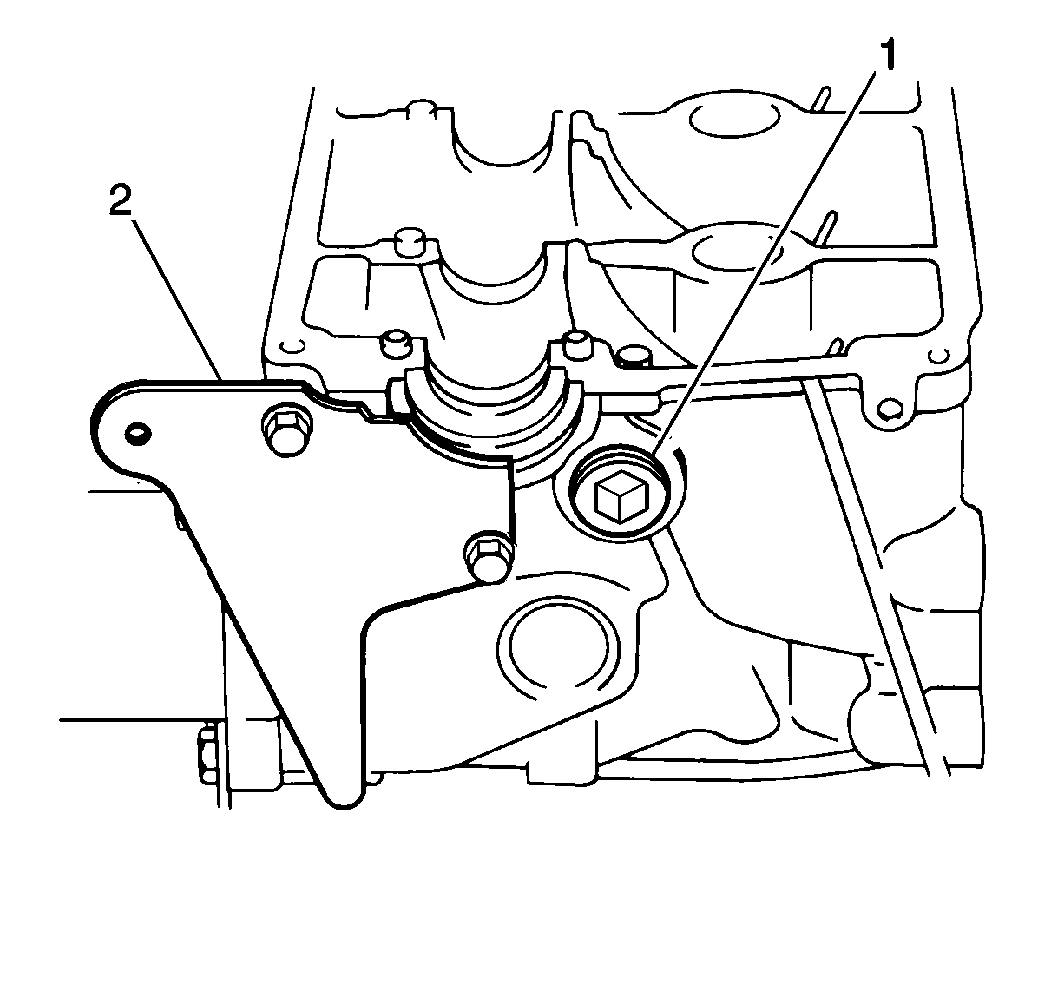
- Remove the two bolts and
the inside timing belt cover (2) from the cylinder head.
- Remove two bolts and the A/C mounting bracket with the compressor
from the cylinder head.
- Remove the distributor from the distributor case. Refer to
Distributor Replacement
in Engine
Electrical.

- Remove six bolts and the
cylinder head cover (1) from the cylinder head (2).
- Remove the cylinder head cover gasket and the O-rings from the
cylinder head cover.
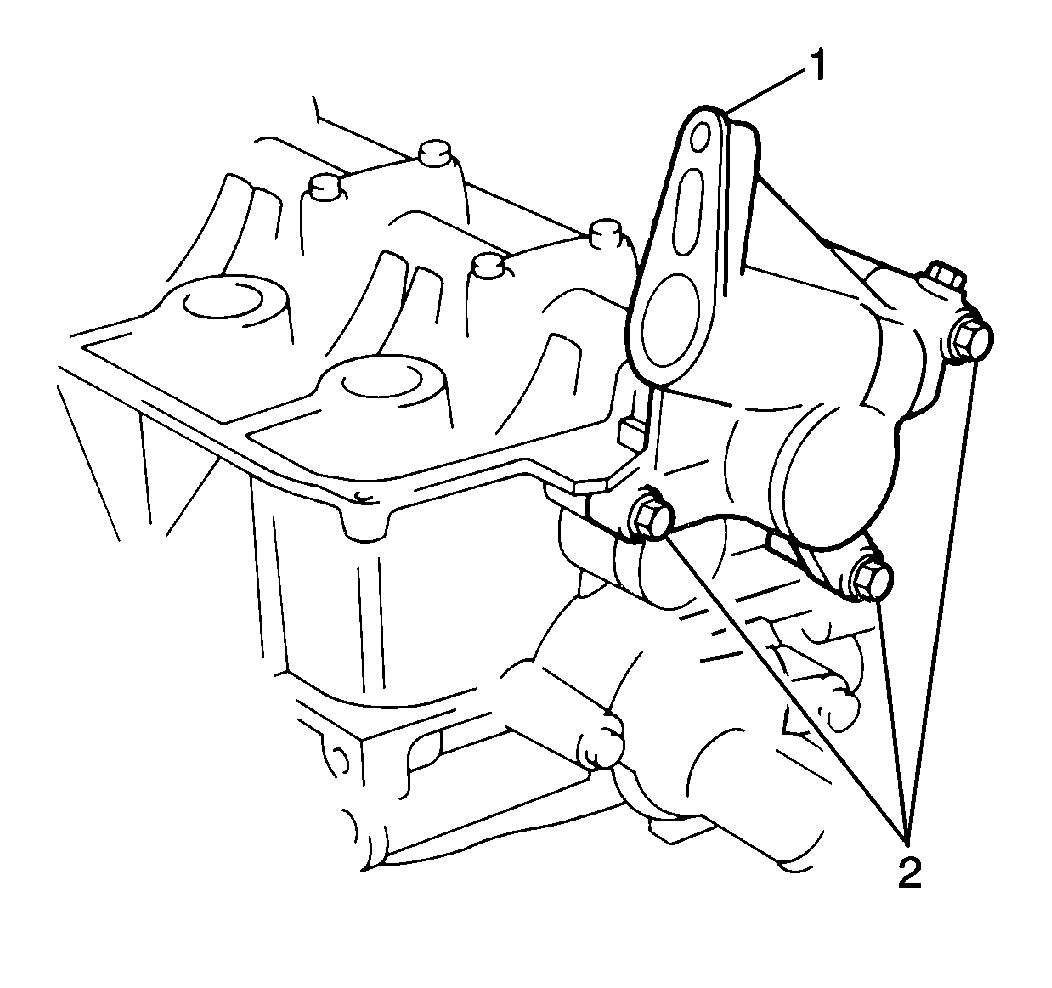
Important: A small amount of oil may drain from the distributor case upon removal
from the cylinder head. Place a suitable container underneath the distributor
case or use a shop towel to catch and absorb oil.
- Remove three bolts and the distributor case (1) from the cylinder head.
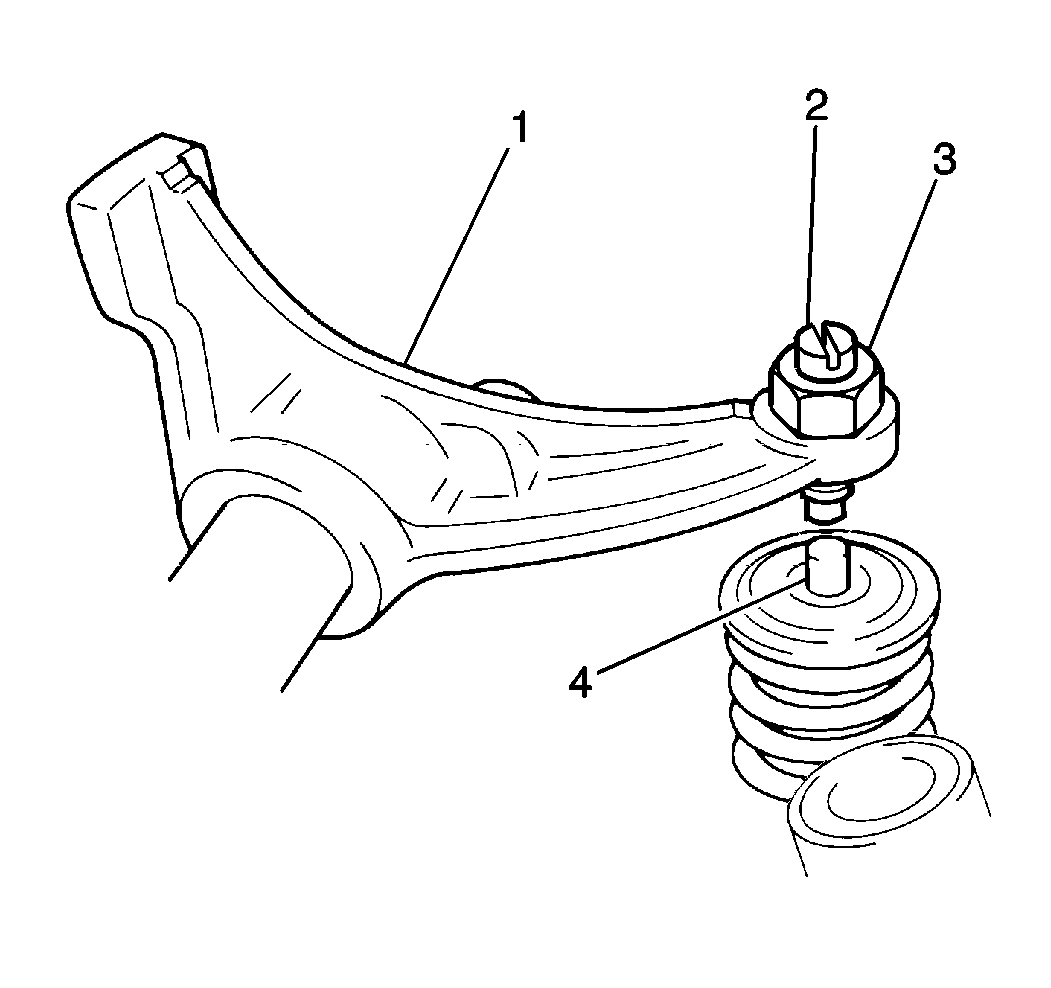
- Loosen all of the valve
adjusting screw locknuts (3).
- Loosen all of the valve adjusting screws (2) until all the rocker
arms (1) move freely.
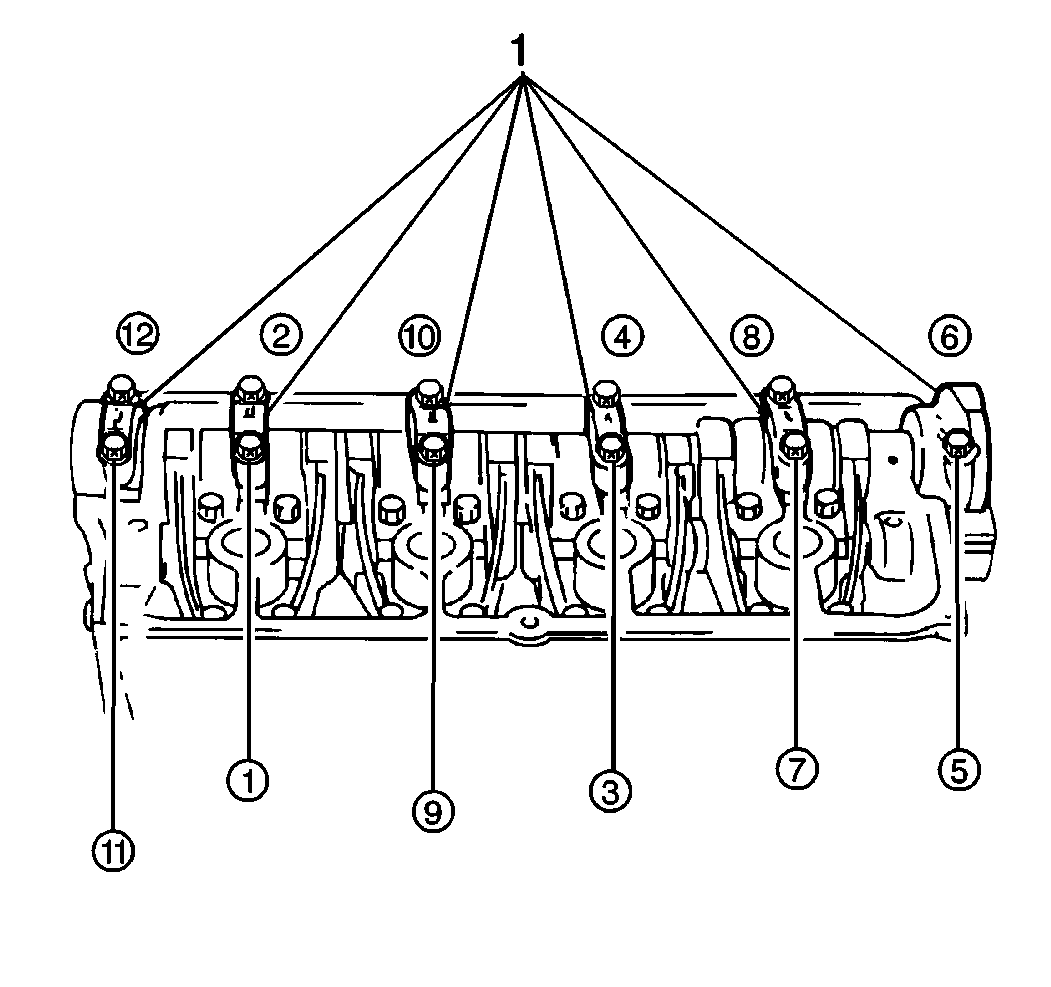
Notice: Always loosen the camshaft carrier bolts gradually and in the order
shown, in order to relieve tension on the camshaft. If the camshaft carrier
bolts are removed at random, damage to the camshaft may occur.
- Remove the following from the cylinder head:
| • | The camshaft carrier caps |

Important: Loosen the cylinder head bolts gradually in the specified sequence to
prevent the cylinder head distortion.
- Remove the following from the cylinder block:
| • | The cylinder head gasket |
- Clean the mating surfaces of the following:
| • | The distributor gear case of all gasket or sealant materials |
- Clean all bolt threads and bolts.
- Inspect the cylinder head. Refer to Cylinder Head Clean and inspect.

Notice: Use the correct fastener in the correct location. Replacement fasteners
must be the correct part number for that application. Fasteners requiring
replacement or fasteners requiring the use of thread locking compound or sealant
are identified in the service procedure. Do not use paints, lubricants, or
corrosion inhibitors on fasteners or fastener joint surfaces unless specified.
These coatings affect fastener torque and joint clamping force and may damage
the fastener. Use the correct tightening sequence and specifications when
installing fasteners in order to avoid damage to parts and systems.
- Inspect the oil
jet in the cylinder head (1) for any obstructions and ensure that the oil
jet (2) is tightened to its torque specification.
Tighten
Tighten the oil jet to 5 N·m (44 lb in).
- Apply clean engine oil to the threaded portion of all of the cylinder
head bolts.

- Install the new cylinder
head gasket and the cylinder head with the distributor case onto the cylinder
block. Secure the components with ten bolts (1).
Notice: Use the correct fastener in the correct location. Replacement fasteners
must be the correct part number for that application. Fasteners requiring
replacement or fasteners requiring the use of thread locking compound or sealant
are identified in the service procedure. Do not use paints, lubricants, or
corrosion inhibitors on fasteners or fastener joint surfaces unless specified.
These coatings affect fastener torque and joint clamping force and may damage
the fastener. Use the correct tightening sequence and specifications when
installing fasteners in order to avoid damage to parts and systems.
- Tighten the cylinder
head bolts in three separate steps, following the illustrated sequence.
Tighten
- Tighten the ten cylinder head bolts on the first pass to 35 N·m
(26 lb ft).
- Tighten the ten cylinder head bolts on the second pass to 55 N·m
(41 lb ft).
- Tighten the ten cylinder head bolts on the final (third) pass
to 70 N·m (52 lb ft).
- Apply a liberal amount of clean engine oil to the camshaft.
- Apply GM P/N 12346240 or the equivalent to the bottom of the number
6 camshaft carrier cap.
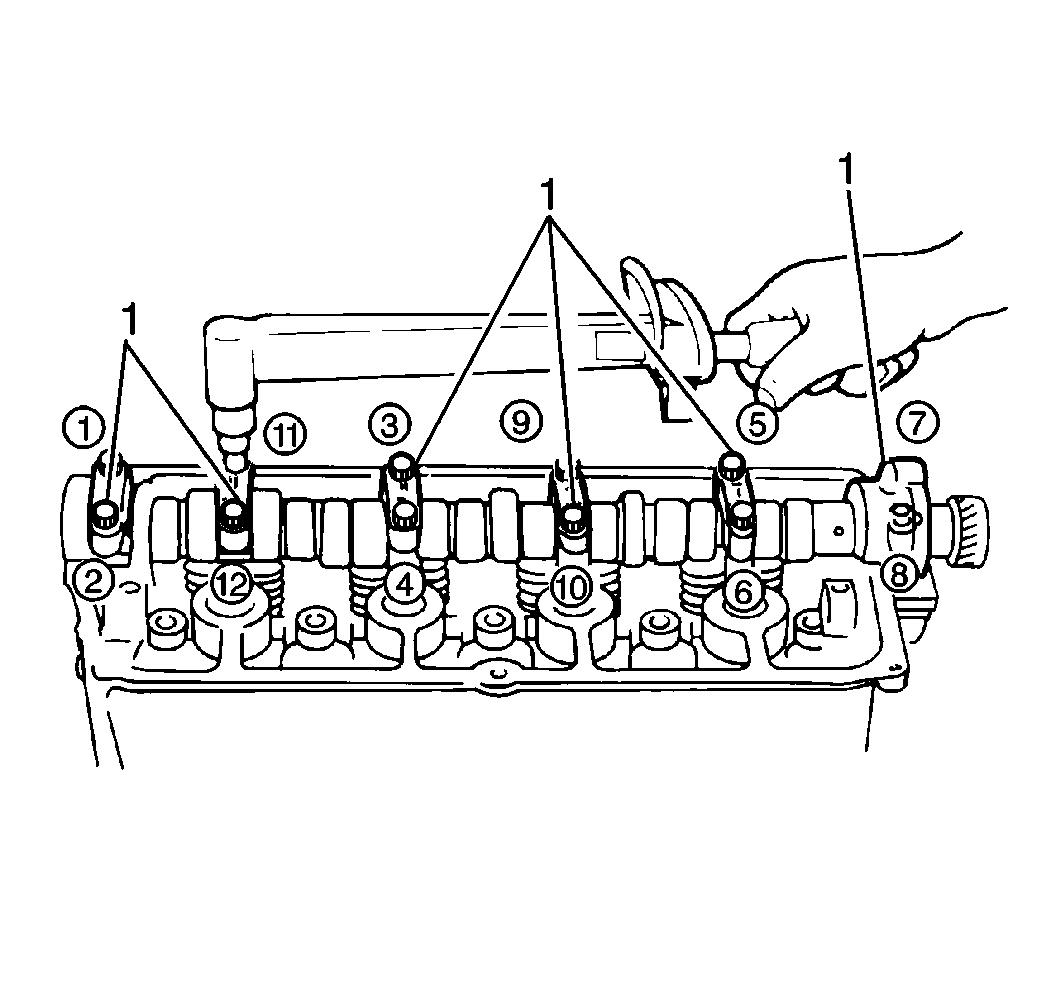
Notice: Always tighten the camshaft carrier cap bolts gradually in the order
shown. If the camshaft carrier cap bolts are tightened at random, damage to
the camshaft may occur
- Install the camshaft and the camshaft carrier caps (1) onto the cylinder
head.
- Secure the camshaft and the camshaft carrier caps with 12 bolts.
Tighten
Tighten the camshaft carrier cap to 10 N·m (89 lb in).
- Apply engine oil to the new camshaft seal lip.
- Install the new camshaft seal into the cylinder head until the
camshaft seal is flush with the camshaft carrier surface.
- Adjust the valve lash. Refer to Valve Lash.
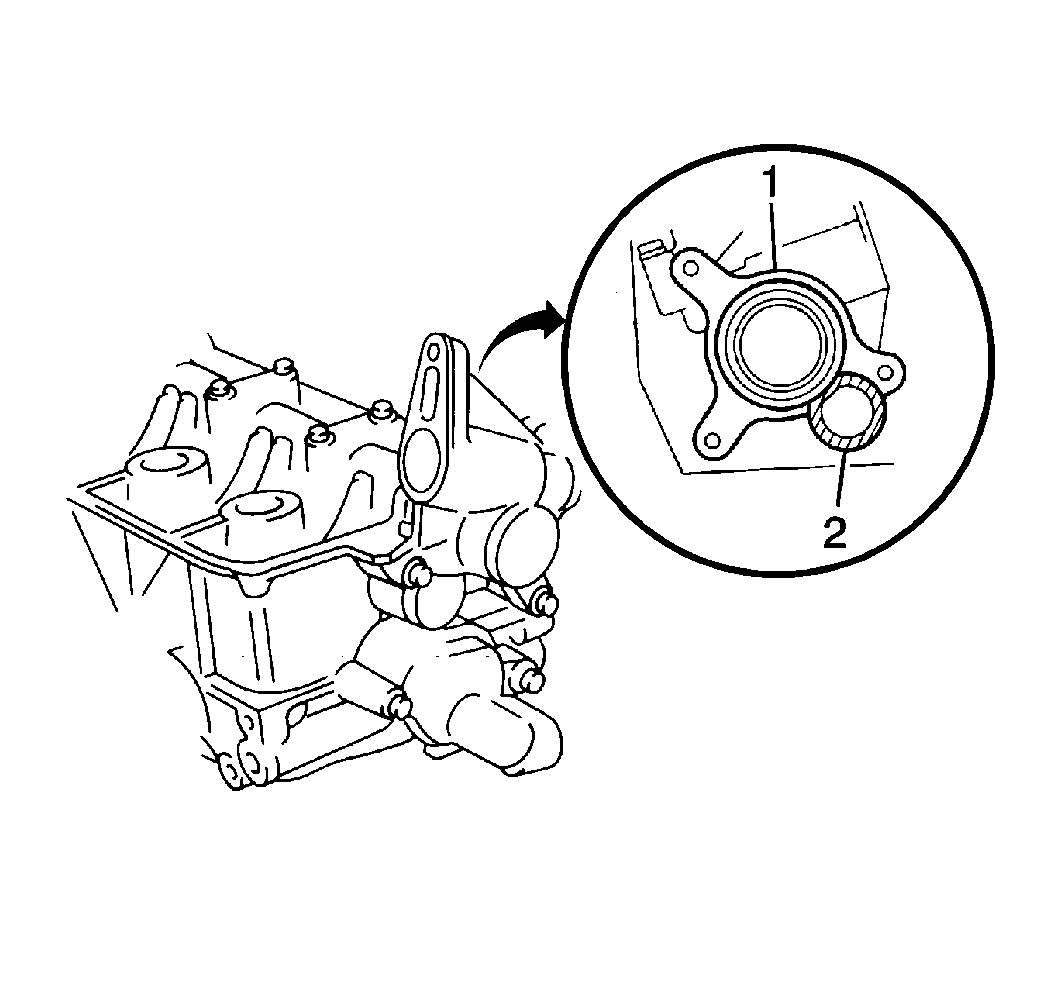
- Apply GM P/N 12346340
or the equivalent to the surface of the distributor case (1) that mates with
the rear rocker arm shaft.
- Install the distributor case to the cylinder head.
- Secure the distributor case with three bolts.
Tighten
Tighten the distributor case bolts to 10 N·m (89 lb in).
- Clean the sealing surfaces on the cylinder head and the cylinder
head cover.
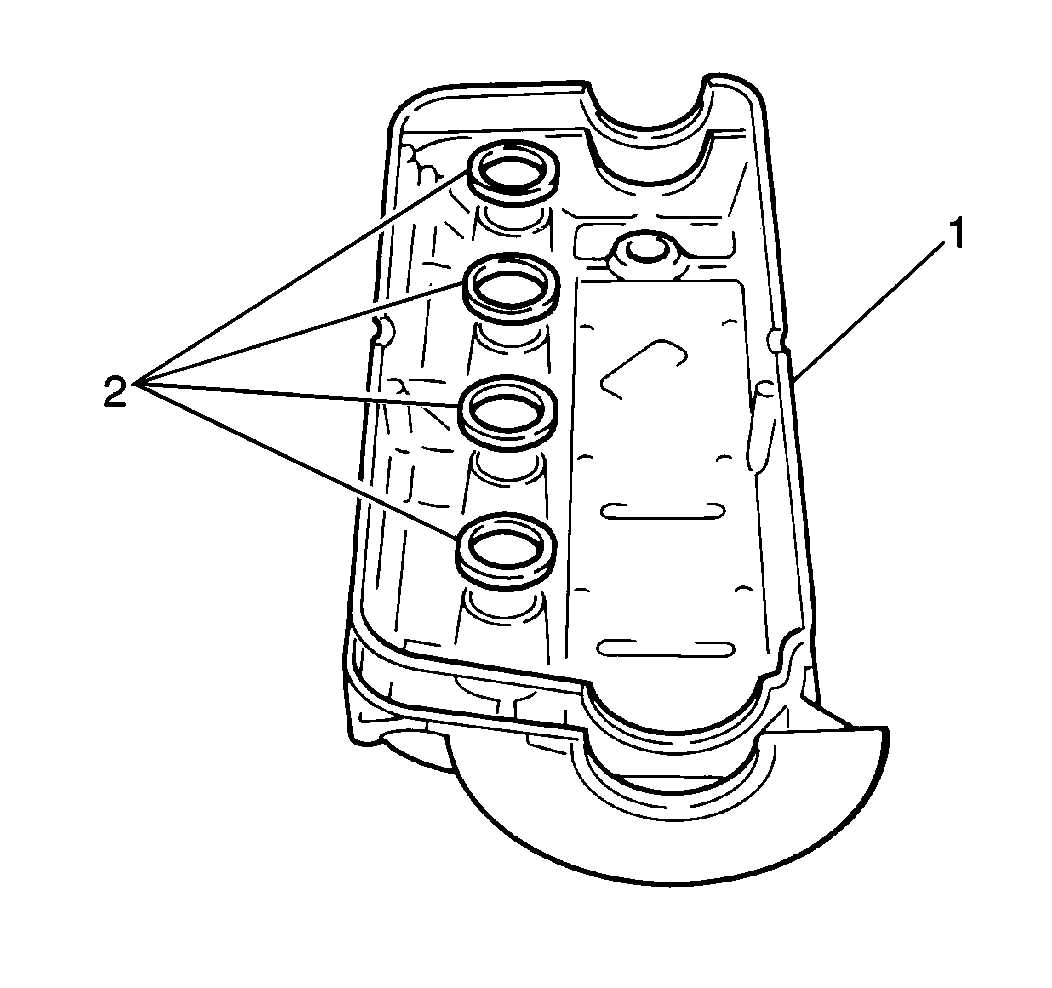
Important: A new cylinder head cover gasket and O-rings must be used whenever a
cylinder head cover removal and installation is performed. Ensure that new
gasket and O-rings are correctly positioned during the cylinder head cover
installation.
- Install a new head cover gasket and four O-rings (2) to the cylinder
head cover (1).
- Install the cylinder head cover to the cylinder head.
- Secure the cylinder head cover with six bolts.
Tighten
Tighten the cylinder head cover bolts to 10 N·m (89 lb in).
- Install the distributor into the distributor case. Refer to
Distributor Replacement
in Engine
Electrical.
- Install the A/C mounting bracket with the compressor to the cylinder
head.
- Secure the A/C mounting bracket and the compressor with two bolts.
Tighten
Tighten the A/C mounting bracket bolts to 10 N·m (89 lb in).

- Install the timing belt
cover (2) to the cylinder head.
- Secure the timing belt cover with two bolts.
Tighten
Tighten the timing belt cover bolts to 10 N·m (89 lb in).
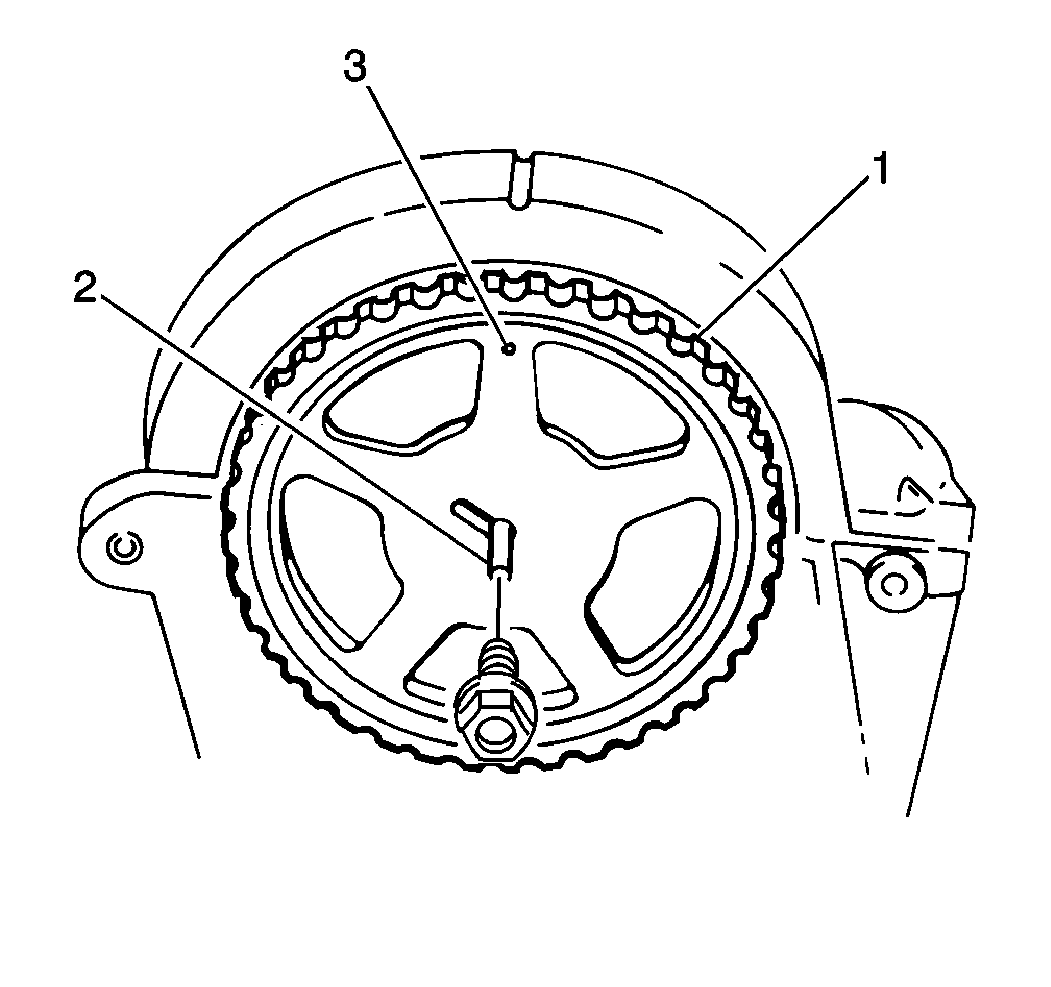
Important: During the camshaft timing belt gear installation, align the camshaft
dowell pin (2) with the slot in the camshaft timing belt gear designated as
E.
- Use a J 41040
in
order to install the camshaft timing belt gear onto the camshaft.

- Hold the camshaft timing
belt gear stationary. Secure the camshaft timing belt with one bolt.
Tighten
Tighten the camshaft timing belt gear bolt to 60 N·m (44 lb ft).

Important: Do not tighten the timing belt tensioner stud and bolt to specification
until the timing belt is properly installed. Install the timing belt tensioner
stud and bolt finger tight only.
- Install the timing belt tensioner plate (1) and the tensioner (5) to
the engine. Secure the timing belt tensioner stud and bolt.
Notice: When installing a new or used timing belt, the directional arrows on
the timing belt must be matched with the rotation of the crankshaft. If this
precaution is not observed, excessive wear and timing belt failure may occur.
- Push the timing belt tensioner plate up for the timing belt installation.

- Install the timing belt
onto the camshaft and the crankshaft timing belt gears.
- Inspect the timing marks on the cylinder head cover and the camshaft
timing belt gear for alignment. Inspect the timing marks on the oil pump casting
(2) and the crankshaft timing belt gear (1). If these two sets of timing
marks are not properly aligned, remove the timing belt and align both
sets of marks as previously outlined in this procedure.

- Install the timing belt
tensioner spring to the timing belt tensioner plate (1).
Tighten
| • | Tighten the timing belt tensioner stud to 11 N·m
(97 lb in). |
| • | Tighten the timing belt tensioner bolt to 27 N·m
(20 lb ft). |
Important: Rotate the crankshaft two complete revolutions to remove any slack from
the timing belt and to properly seat the timing belt. When all slack has been
removed from the timing belt, inspect both sets of timing marks to ensure
that they are aligned respectively.
- Install the timing belt cover to the engine. Secure the timing belt
cover with one nut and eight bolts.
Tighten
Tighten the timing belt cover nut and bolts to 10 N·m (89 lb in).
- Install the oil pressure sending unit wire conduit to the timing
belt cover.

- Install the crankshaft
pulley (4) to the crankshaft. Secure the crankshaft pulley with five bolts
(3).
Tighten
Tighten the crankshaft pulley bolts to 16 N·m (12 lb ft).
- Install the radiator shroud to the radiator. Secure the radiator
shroud with two bolts.
Tighten
Tighten the upper shroud bolts to 11 N·m (97 lb in).
- Carefully reposition the A/C suction line and the brackets to
the right side of the radiator core support (if equipped). Secure the A/C
suction line and the brackets with two bolts.
Tighten
Tighten the A/C suction line and the bracket bolts to 10 N·m
(89 lb in).
- Raise and support the vehicle. Refer to
Lifting and Jacking the Vehicle
in General Information.
- Install the two lower radiator shroud bolts.
Tighten
Tighten the lower shroud bolts to 11 N·m (97 lb in).
- Install the front skid plate to the undercarriage (if equipped).
Secure the front skid plate with four bolts.
Tighten
Tighten the front skid plate bolts to 55 N·m (40 lb ft).
- Lower the vehicle.
- Install the coolant pump pulley and the cooling fan to the coolant
pump. Secure the pulley and fan with four nuts.
Tighten
Tighten the coolant fan nuts to 11 N·m (97 lb in).
- Install the generator/coolant pump drive belt to the pulleys.
- Install the A/C compressor (if equipped) and/or power steering
drive belt to pulleys.
- Adjust the generator/coolant pump drive belt. Refer to Cooling
and Radiator.
- Adjust the A/C compressor (if equipped) and/or power steering
drive belt. Refer to HVAC and/or Power Gear and Pump.

- Install a new exhaust
manifold gasket (1) and the exhaust manifold (2) with the engine hanger to
the cylinder head.

- Secure the new exhaust
manifold gasket and the exhaust manifold with nine nuts (1).
Tighten
Tighten the exhaust manifold nuts to 23 N·m (17 lb ft).
- Raise and support the vehicle. Refer to
Lifting and Jacking the Vehicle
in General Information.

- Install the front pipe/TWC
assembly (3) with the new gasket (2) to the exhaust manifold (1). Secure
the front pipe/TWC assembly with three bolts
Tighten
Tighten the exhaust manifold-to-front pipe/TWC assembly bolts to 50 N·m
(37 lb ft).

- Install the lower exhaust
manifold heat shield (6) to the exhaust manifold (2). Secure the lower exhaust
manifold heat shield (6) with two bolts.
Tighten
Tighten the lower exhaust manifold heat shield bolts to 10 N·m
(89 lb in).

- Install the exhaust manifold
bracket (1) to the exhaust manifold and engine block. Secure the exhaust
manifold bracket (1) with one nut and two bolts.
Tighten
| • | Tighten the mount-to-exhaust bracket bolts to 54 N·m
(54 lb ft). |
| • | Tighten the bracket-to-exhaust manifold nut to 50 N·m
(37 lb ft). |
- Lower the vehicle.

- Install the upper exhaust
manifold heat shield (3) to the exhaust manifold (2). Secure the upper exhaust
manifold heat shield with two nuts and three bolts
Tighten
Tighten the upper exhaust manifold heat shield nuts and bolts to 10 N·m
(89 lb in).
- Install the air intake pipe bracket to the cylinder head. Secure
the air intake pipe bracket with three bolts.
Tighten
Tighten the air intake pipe bracket bolts to 10 N·m (89 lb in).
- Install a new intake manifold gasket and intake manifold with
the intake surge tank and throttle body to the cylinder head. Secure the intake
manifold gasket and intake manifold with the intake surge tank and throttle
body with eight nuts and three bolts.
Tighten
Tighten the intake manifold nuts and bolts to 23 N·m (17 lb ft).

- Install the lower intake
manifold support bracket (3) to the intake manifold. Secure the lower intake
manifold support bracket with two bolts.
Tighten
Tighten the lower intake manifold support bracket bolts to 50 N·m
(37 lb ft).
- Install the rear intake manifold reinforcement bracket (1) to
the intake manifold. Secure the rear intake manifold reinforcement bracket
with two bolts.
Tighten
Tighten the rear intake manifold support bracket bolts to 50 N·m
(37 lb ft).
- Install the front intake manifold reinforcement bracket (2) to
the intake manifold. Secure the front intake manifold reinforcement bracket
with two bolts.
Tighten
Tighten the front intake manifold support bracket bolts to 50 N·m
(37 lb ft).

- Install the generator
adjusting arm bracket (1) to the intake manifold. Secure the generator adjusting
arm bracket with one bolt and one nut.
Tighten
Tighten the generator adjusting arm bracket nut and bolt to 50 N·m
(37 lb ft).
- Install the coolant bypass hose to the intake manifold.
- Install the upper radiator hose to the thermostat housing.
- Tighten the upper radiator hose clamp at the thermostat housing.
- Install the PCV hose to the PCV valve.
- Connect the fuel return hose to the fuel return line.

- Install the fuel feed
hose at the fuel feed hose union (1).
- Install the coolant hoses to the fast idle air valve below the
throttle body.
- Install the IAC air hose to the IAC valve.
- Install the coolant hose to the IAC valve.
- Install the following vacuum hoses:
| • | The EGR valve modulator |
| • | The brake booster supply hose |
| • | The vacuum modulator supply hose (automatic transmission equipped
vehicles) |
| • | The intake manifold absolute pressure sensor hose. |

- The install the following
electrical connectors:
| • | The engine ground wire (7) to intake the surge tank |
| • | The EGR solenoid vacuum valve (1) |
| • | The EGR by-pass vacuum valve |
| • | The exhaust gas recirculation (EGR) temperature sensor |
| • | The evaporative emission solenoid purge (EVAP SP) valve. |
| • | The A/C ECT switch (3) (A/C equipped vehicles only) |
| • | The ECT sensor sending unit |
| • | The engine coolant temperature (ECT) sensor (4) |
| • | The Idle Air Control (IAC) Valve |
| • | The Throttle Position (TP) Sensor |

- Install the accelerator
cable bracket (2) to the throttle body. Secure the cable bracket with one
screw, one bolt and one nut.
Tighten
Tighten the throttle body nut and bolt to 23 N·m (17 lb ft).
- Install the accelerator cable (3) and the kickdown cable (4) (automatic
transmission equipped vehicles) to the throttle body bellcrank (1).
- Adjust the accelerator as necessary. Refer to
Accelerator Control Cable Replacement
in Engine
Controls.
- Adjust the kickdown cable (automatic transmission equipped vehicles)
as necessary. Refer to Automatic Transmission.
- Install the throttle cover from the intake manifold.
- Secure the throttle cover with three bolts
Tighten
Tighten the throttle cover bolts to 15 N·m (11 lb ft).
- Refill the cooling system as necessary. Refer to
Cooling System Draining and Filling
in Engine Cooling.
- Install the air intake pipe to the throttle body hose and the
ACL intake hose. Refer to Air Intake Pipe Replacement.
- Install the negative battery cable. Refer to
Battery Replacement
in Engine Electrical.














































